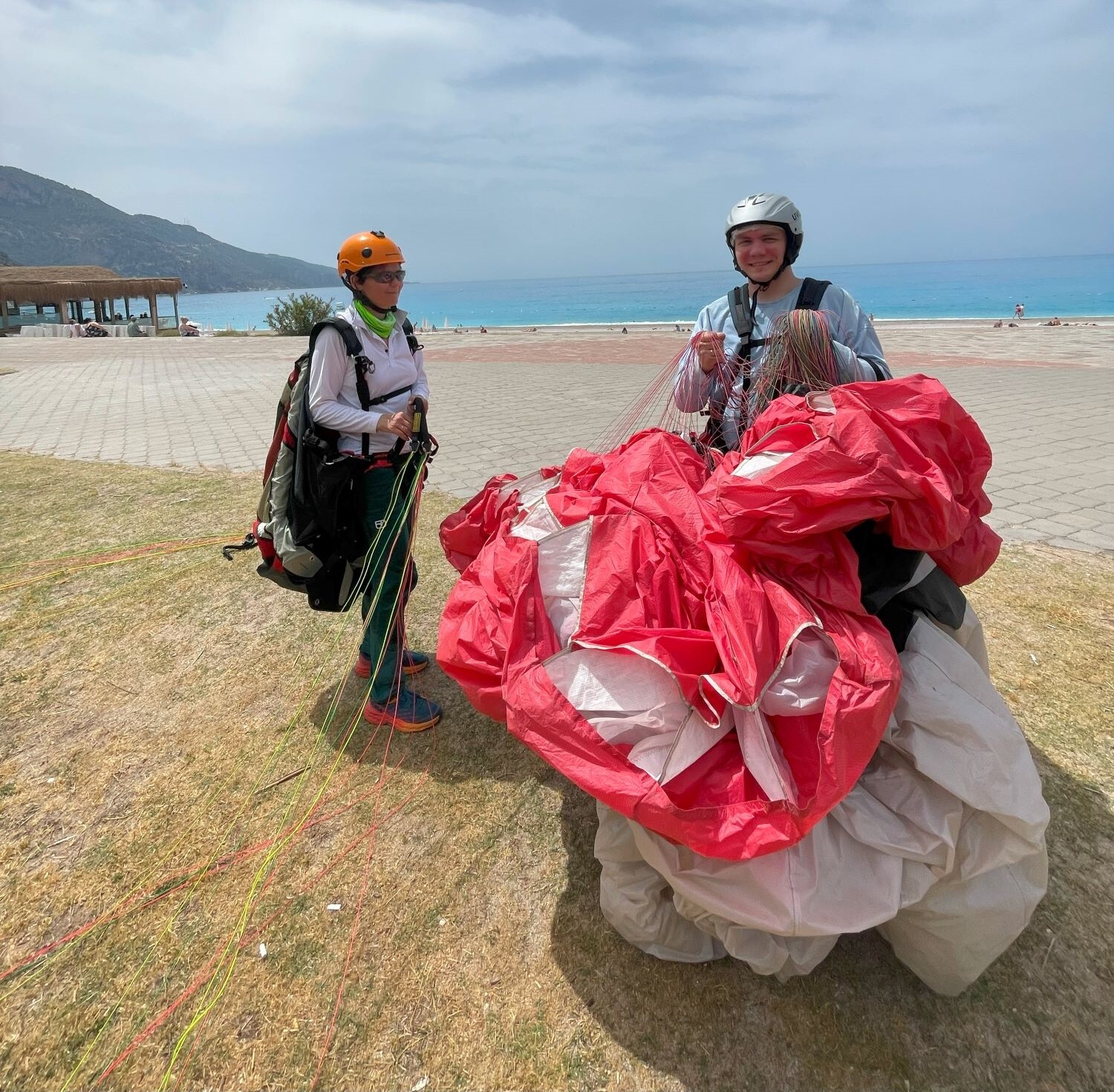"From zero to hero"
For those who value their time.
Includes one-on-one instruction with an instructor and personal attention.
• There are 2 instructors during flights, releasing and receiving
• Tandem flight with instructor
• Independent flights under the supervision of instructors
• Flights from small hills 30-100 meters high. Approximately: 35 solo flights.
Photo video Filming during the course.
3 books on paragliding, video instructions, audio materials: support and advice from an instructor for 6 months
If you prefer to learn 1-1, we can offer you 12-14 days of private lessons with the best instructors in the business. Confidence is important when flying, which is why we want to provide you with a rigorous training program to ensure you become as independent and confident a pilot as possible.
1-1 lessons will ensure that your education is as thorough and in-depth as possible. For absolute beginners or those who have already started their training.
For more information or to discuss, simply write to us



Course program: “From zero to hero” (Individual training with two instructors)
Level: P2; P3;
Course duration: 14 days (12 training days + 2 days off)
Venue: Oludeniz, Mount Babadag
Course objective: A complete path from a beginner to a confident pilot ready for solo flights. An individual approach with two instructors (one who releases at the start and one who accepts at the landing) guarantees maximum safety and training efficiency.
Day 1: Introduction and ground training
• Theory:
1. Introduction to the course program and instructors.
2. The structure of the paraglider and equipment.
3. Safety basics: takeoff, flight, landing.
4. Primary meteorology: how to assess weather conditions for flights.
• Practice:
1. Familiarization with the paraglider: packing, equipment check.
2. Ground training: wing lift, holding in the “window”.
3. Line control and basic wing control skills on the flat.
Day 2: Training at the training airfield
• Theory:
1. Safe takeoff and run-up techniques.
2. How to distribute weight and control the wing.
3. Landing basics: how to choose a place and land correctly.
• Practice:
1. Takeoff from the ground.
2. First “hops” with wing control.
3. Landing accuracy training.
Day 3: First solo flights from a low altitude
• Theory:
1. Basic control in the air: turns, descent, stabilization.
2. Air traffic rules: priorities in the air.
• Practice:
1. Flights from an altitude of 30-50 m under the radio control of the release.
2. Performing simple maneuvers: straight and level flight, slight turns.
3. Landing with consideration for terrain and wind.
Day 4: Increasing altitude and wing control
• Theory:
1. Basic aerodynamics: lift, speed, drag.
2. How to control speed and use the accelerator.
3. Introduction to unstable wing states (frontal and lateral collapse).
• Practice:
1. Flying from 50–100 m.
2. Active piloting training: wing control in the air.
3. Landing in various conditions (strong wind, confined area).
Day 5: Thermal Soaring
• Theory:
1. What are thermals and how to find them.
2. Basics of thermal soaring: entry, hold, exit.
3. Climb technique.
• Practice:
1. Flying with an emphasis on finding thermals.
2. Spiral climb training.
3. Wing control when working in thermals.
Day 6: More complex maneuvers
• Theory:
1. Powerful maneuvers: steep turns, ears, B-line.
2. Wing control in strong winds.
3. Analysis of complex situations: what to do when the lines twist or the wing collapses.
• Practice:
1. Flights from 300 m.
2. Performing complex maneuvers in the air.
3. Landing in difficult areas.
Day 7: First cross-country flight
• Theory:
1. Route planning: terrain analysis, use of wind and thermals.
2. Safe return to the landing point.
• Practice:
1. Flight over a distance of 5-7 km under radio control.
2. Using thermals and dynamic thermals to maintain altitude.
3. Landing training on the beach of Oludeniz.
Day 8: Day off with a lesson
• Theory (short lesson):
1. Pilot psychology: how to cope with anxiety and fear.
2. Debriefing of previous days: analysis of mistakes and achievements.
• Recommendation:
On this day you can rest, walk around Oludeniz or spend time with the instructor for additional consultations.
Days 9–11: Advanced XC flights
• Theory:
1. Advanced route planning: how to use GPS and weather data.
2. Working with dynamic flows along slopes.
3. How to save altitude and energy.
• Practice:
1. XC flights of 10–15 km.
2. Climbing to 1000 m above the takeoff.
3. Flights with minimal radio support.
Day 12: Flight from maximum altitude (2000 m)
• Theory:
1. Final review of all theoretical knowledge.
2. Tips for moving to P3 level.
• Practice:
1. Flight from maximum altitude on Babadag (2000 m).
2. Demonstration of all skills: takeoff, climb, maneuvers, landing.
3. Complete independence with minimal supervision.
Day 13: Day off with preparation for the final exam
• Theory (short lesson):
1. Review of all course material.
2. Preparation for final flights and certification.
Day 14: Final flights and certification
• Practice:
1. Performing two route flights using all the learned techniques.
2. Demonstration of skills for certification.
• Final:
• Debriefing, summing up the course.
• Awarding of the P2 pilot certificate; P3; depending on the results of the exam and the practical part.
• Photo session as a souvenir and recommendations for further development.
Additional:
• Equipment: Provided by the school for the entire course.
• Individual consultations: Constant communication with instructors for maximum progress.
• Bonus: Discount on subsequent courses (P3).
